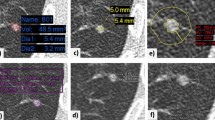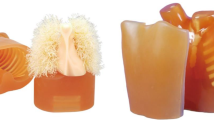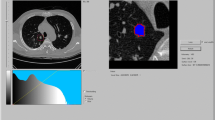Abstract
The purpose of this study is to assess the variance and error in nodule diameter measurement associated with variations in nodule-slice position in cross-sectional imaging. A computer program utilizing a standard geometric model was used to simulate theoretical slices through a perfectly spherical nodule of known size, position, and density within a background of “lung” of known fixed density. Assuming a threshold density, partial volume effect of a voxel was simulated using published slice and pixel sensitivity profiles. At a given slice thickness and nodule size, 100 scans were simulated differing only in scan start position, then repeated for multiple node sizes at three simulated slice thicknesses. Diameter was measured using a standard, automated algorithm. The frequency of measured diameters was tabulated; average errors and standard deviations (SD) were calculated. For a representative 5-mm nodule, average measurement error ranged from +10 to −23 % and SD ranged from 0.07 to 0.99 mm at slice thicknesses of 0.75 to 5 mm, respectively. At fixed slice thickness, average error and SD decreased from peak values as nodule size increased. At fixed nodule size, SD increased as slice thickness increased. Average error exhibited dependence on both slice thickness and threshold. Variance and error in nodule diameter measurement associated with nodule-slice position exists due to geometrical limitations. This can lead to false interpretations of nodule growth or stability that could affect clinical management. The variance is most pronounced at higher slice thicknesses and for small nodule sizes. Measurement error is slice thickness and threshold dependent.





Similar content being viewed by others
References
MacMahon H, Austin JH, Gamsu G, et al: Guidelines for management of small pulmonary nodules detected on CT scans: a statement from the Fleischner Society. Radiology 237(2):395–400, 2005
Eisenhauer EA, Therasse P, Bogaerts J, et al: New response evaluation criteria in solid tumours: revised RECIST guideline (version 1.1). Eur J Cancer 45(2):228–247, 2009
Organization WH. WHO (World Health Organization, Genf): Handbook for Reporting Results of Cancer Treatment: WHO, 1979
Marten K, Engelke C: Computer-aided detection and automated CT volumetry of pulmonary nodules. Eur Radiol 17(4):888–901, 2007
Buckler AJ, Mulshine JL, Gottlieb R, Zhao B, Mozley PD, Schwartz L: The use of volumetric CT as an imaging biomarker in lung cancer. Acad Radiol 17(1):100–106, 2010
Gavrielides MA, Kinnard LM, Myers KJ, et al: A resource for the assessment of lung nodule size estimation methods: database of thoracic CT scans of an anthropomorphic phantom. Opt Express 18(14):15244–15255, 2010
Gavrielides MA, Kinnard LM, Myers KJ, Petrick N: Noncalcified lung nodules: volumetric assessment with thoracic CT. Radiology 251(1):26–37, 2009
McNitt‐Gray M: MO‐A‐ValB‐01: Tradeoffs in Image Quality and Radiation Dose for CT. Med Phys 33:2154, 2006
Xu DM, van Klaveren RJ, de Bock GH, et al: Role of baseline nodule density and changes in density and nodule features in the discrimination between benign and malignant solid indeterminate pulmonary nodules. Eur J Radiol 70(3):492–498, 2009
Sverzellati N, Randi G, Spagnolo P, et al: Increased mean lung density: another independent predictor of lung cancer? Eur J Radiol 82(8):1325–1331, 2013
Mozley PD, Bendtsen C, Zhao B, et al: Measurement of tumor volumes improves RECIST-based response assessments in advanced lung cancer. Transl Oncol 5(1):19–25, 2012
Goodman LR, Gulsun M, Washington L, Nagy PG, Piacsek KL: Inherent variability of CT lung nodule measurements in vivo using semiautomated volumetric measurements. AJR Am J Roentgenol 186(4):989–994, 2006
Wormanns D, Kohl G, Klotz E, et al: Volumetric measurements of pulmonary nodules at multi-row detector CT: in vivo reproducibility. Eur Radiol 14(1):86–92, 2004
Xu DM, Gietema H, de Koning H, et al: Nodule management protocol of the NELSON randomised lung cancer screening trial. Lung Cancer 54(2):177–184, 2006
Xu DM, van der Zaag-Loonen HJ, Oudkerk M, et al: Smooth or attached solid indeterminate nodules detected at baseline CT screening in the NELSON study: cancer risk during 1 year of follow-up. Radiology 250(1):264–272, 2009
Author information
Authors and Affiliations
Corresponding author
Rights and permissions
About this article
Cite this article
Juluru, K., Al Khori, N., He, S. et al. A Mathematical Simulation to Assess Variability in Lung Nodule Size Measurement Associated With Nodule-Slice Position. J Digit Imaging 28, 373–379 (2015). https://doi.org/10.1007/s10278-014-9753-5
Published:
Issue Date:
DOI: https://doi.org/10.1007/s10278-014-9753-5




